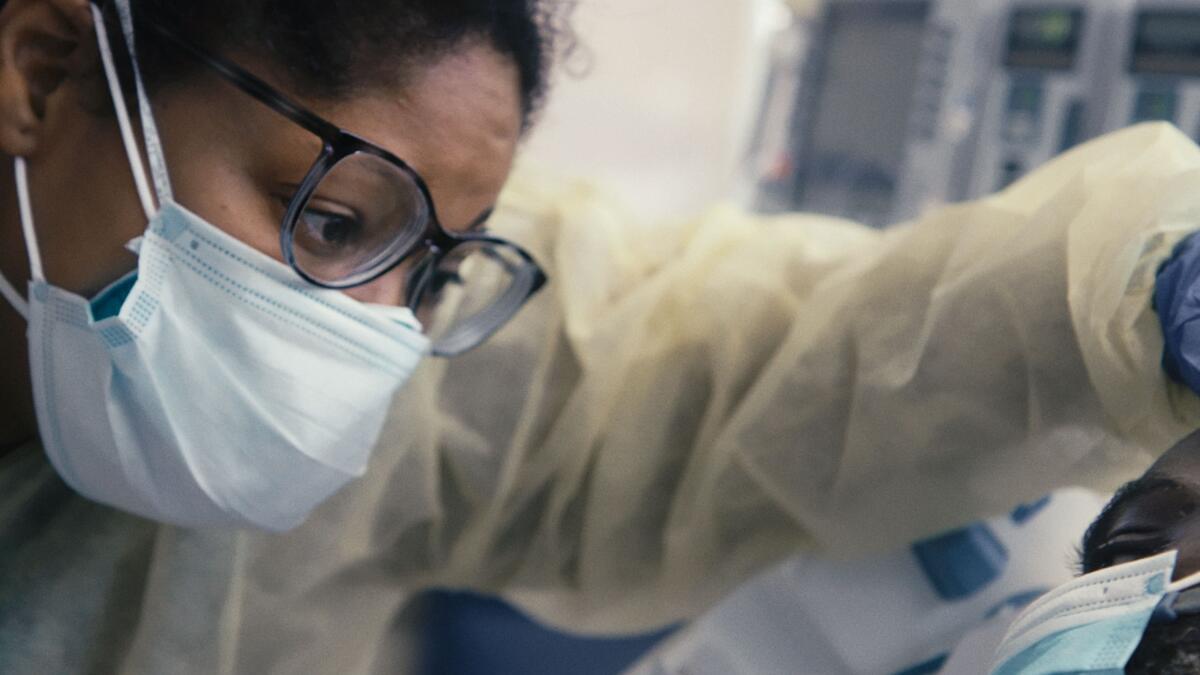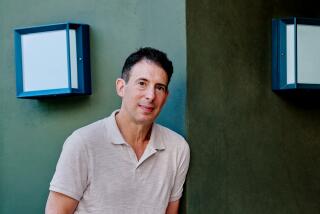Review: Disturbing ‘The First Wave’ plants viewers on front lines of the pandemic’s early days

The Times is committed to reviewing theatrical film releases during the COVID-19 pandemic. Because moviegoing carries risks during this time, we remind readers to follow health and safety guidelines as outlined by the Centers for Disease Control and Prevention and local health officials.
Months after the authorization of the COVID-19 vaccine, with mask mandates lifted, unemployment benefits and rent assistance ended, and students back in school, Americans might be lulled into believing that the pandemic is over. But escalating inflation and ongoing supply-chain shortages will counteract that, and so too might increasing infection numbers as the holiday season begins. Into this shifting landscape, with one foot still in “unprecedented times” and one foot in “back to normal,” arrives Matthew Heineman’s viscerally disturbing and achingly humanistic documentary “The First Wave.”
From March to June 2020, Heineman had exclusive access to New York City’s Long Island Jewish (LIJ) Medical Center, which admitted its first COVID-19 patient on March 3, 2020. (And, in a dispiriting sign of the times, owner Northwell Health recently let 1,400 employees system-wide go for refusing to get vaccinated.) Like other hospitals around the country last year, LIJ was thrust into ever-transforming mandates from the city and on-the-fly medical protocols. Doctors, nurses and other healthcare providers were overwhelmed and overworked, trying to pull together enough clinical experience and research to care for those infected with COVID-19. The hospital’s resources weren’t enough — not enough ventilators, not enough masks, not enough rooms. Yet patients kept coming, and COVID-19 kept spreading.
Spring 2020 might seem a lifetime ago, but “The First Wave” transports us back and places us alongside front-line workers doing all they can to save everyone they can. Depending on viewers’ personal experiences during the COVID-19 pandemic, watching “The First Wave” might be either traumatizing or retraumatizing. But Heineman respects his subjects’ humanity while emphasizing the dire circumstances in which they find themselves, and the jarring transitions between shots of people’s faces and shots of their wrapped-up bodies serve a purpose.
Outside LIJ, frantic calls between 911 operators and EMTs play — “I implore you to please answer as quickly as possible” — while police sirens wail in the distance and lines of ambulances and their drivers wait to drop off patients. Inside LIJ, the beeping of medical apparatus and employee pagers, the crackling of overhead hospital announcements of another emergency code blue and the rapid thumping of chest compressions convey the frantic nature of each day and night. The only quiet comes when the healthcare teams observe a minute of silence — only one — for each patient lost, and that stillness accumulates as “The First Wave” continues and the body count rises.
Heineman divides his documentary by month but otherwise lets days in LIJ play out seemingly without interruption. The resulting atmosphere is both intimate and uneasy, and the pace is relentless. A well-edited, horrifying sequence takes viewers from room to room with a certain pattern emerging: A nurse in personal protective equipment holds up a phone or tablet in a transparent plastic bag so the patient can communicate with family; the patient seems stable at first but then slips quickly into further illness; and resuscitation efforts, via chest compression, electric shock or epinephrine injection, fail.
“The First Wave” does this again and again until the routine is so well established that viewers can recite the steps of handling a death: Healthcare workers check for a pulse, call the time, then prepare the body to be properly handled according to public health regulations. But even if humans are adaptable and even if we’re used to accepting pain and reacting accordingly, there is no way to watch “The First Wave” without being rattled by the persistent loss of life. The documentary’s opening scene, which takes viewers through an entire journey of hope and despair, is just the first hurdle.
The wear begins to show: On hospital internist Dr. Nathalie Dougé, whose initial frankness and fortitude crumble as she realizes how disproportionately COVID-19 is affecting NYC’s Black, Latinx and immigrant communities. A scene in which a fellow employee leads her from the camera after she delivers a desperate, expletive-filled appeal for more help for LIJ is one of the documentary’s most affecting moments. On ICU nurse Kellie Wunsch, who wearily admits that she understands why young nurses are leaving the profession — “I don’t think that you’re going to find any nurse that’s gonna say they feel like a hero” — before springing into action when her pager goes off. And on the families of COVID-19 patients Ahmed Ellis and Brussels Jabon, a school safety officer and LIJ nurse, respectively, who are intubated as they battle the virus.
“Each one is getting harder and harder,” one LIJ nurse says to another, and “The First Wave” unflinchingly documents the contrasting emotions and tumultuous realities of one of the greatest tragedies in American history. Remember when people used to clap, cheer and celebrate front-line workers at a specified time each day? “The First Wave” — even with its hopeful ending — ultimately feels as if it’s an admonishment of how quickly as a society we set such things aside to return to business as usual. “What do you look like when you come out the other side?” someone wonders, and “The First Wave’s” most pointed, haunting reminder is that we haven’t gotten there yet.
'The First Wave'
Not rated
Running time: 1 hour, 33 minutes
Playing: Starts Nov. 19, Laemmle Monica, Santa Monica; and AMC Orange 30
More to Read
Only good movies
Get the Indie Focus newsletter, Mark Olsen's weekly guide to the world of cinema.
You may occasionally receive promotional content from the Los Angeles Times.










